Related Research Articles

Franklin Patrick Herbert Jr. was an American science-fiction author best known for the 1965 novel Dune and its five sequels. Though he became famous for his novels, he also wrote short stories and worked as a newspaper journalist, photographer, book reviewer, ecological consultant, and lecturer.

Paul Atreides is a fictional character in the Dune universe created by Frank Herbert. Paul is a prominent character in the first two novels in the series, Dune (1965) and Dune Messiah (1969), and returns in Children of Dune (1976). The character is brought back as two different gholas in the Brian Herbert/Kevin J. Anderson novels which conclude the original series, Hunters of Dune (2006) and Sandworms of Dune (2007), and appears in the prequels Paul of Dune (2008) and The Winds of Dune (2009). According to Brian Herbert, Frank Herbert's son and biographer, House Atreides was based on the heroic but ill-fated Greek mythological House Atreus.

Dune is a 1965 science fiction novel by American author Frank Herbert, originally published as two separate serials in Analog magazine. It tied with Roger Zelazny's This Immortal for the Hugo Award in 1966, and it won the inaugural Nebula Award for Best Novel. It is the first installment of the Dune saga, and in 2003 was cited as the world's best-selling science fiction novel.
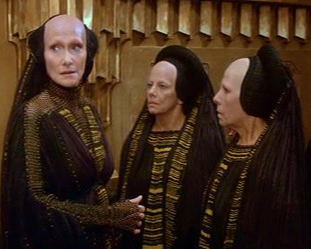
The Bene Gesserit are a key social, religious, and political force in Frank Herbert's fictional Dune universe. The group is described as an exclusive sisterhood whose members train their bodies and minds through years of physical and mental conditioning to obtain superhuman powers and abilities that can seem magical to outsiders. Acolytes who have acquired the breadth of Bene Gesserit abilities are called Reverend Mothers within the organization's ranks. Some of these fictional powers are analyzed and deconstructed from a real-world scientific perspective in the book The Science of Dune (2008).

The Bene Tleilax or Tleilaxu are an extremely xenophobic and isolationist society in Frank Herbert's science fiction Dune universe. Genetic manipulators who traffic in biological products such as artificial eyes, gholas, and "twisted" Mentats, the Tleilaxu are a major power in the Imperium. The race is ruled by a small council of Tleilaxu Masters, whose genetically engineered Face Dancer servants have the ability to mimic any human. The Masters themselves possess a bland and diminutive appearance intended to compel other races to underestimate them. In Heretics of Dune (1984) it is revealed that they are a secret totalitarian theocracy ultimately seeking domination of the known universe. Despite their influence, the Bene Tleilax are universally distrusted and inspire disgust because their products, though desirable, push the moral limits of what humanity at large considers acceptable, and can involve extensive physiological and physical manipulation of human life.
Gaius Helen Mohiam and all the Reverend Mothers within her shuddered. Yes, the Tleilaxu did loathsome things.
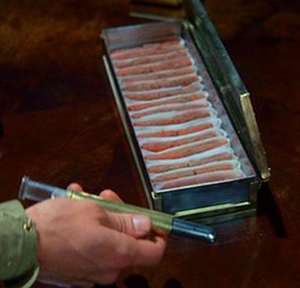
Melange, often referred to as simply "the spice", is the name of the fictional drug central to the Dune series of science fiction novels by Frank Herbert, and derivative works.

Leto II Atreides is a fictional character from the Dune universe created by Frank Herbert. Born at the end of Dune Messiah (1969), Leto is a central character in Children of Dune (1976) and is the title character of God Emperor of Dune (1981). The character is brought back as a ghola in the Brian Herbert/Kevin J. Anderson sequels which conclude the original series, Hunters of Dune (2006) and Sandworms of Dune (2007). Leto also appears as a child in the prequel The Winds of Dune (2009).

Ghanima Atreides is a fictional character from the Dune universe created by Frank Herbert. Born at the end of Dune Messiah (1969), Ghanima is a central character in Children of Dune (1976). She also appears as a child in the Brian Herbert/Kevin J. Anderson prequel The Winds of Dune (2009).

Dune is a science fiction media franchise that originated with the 1965 novel Dune by Frank Herbert and has continued to add new publications up to 2017. Dune is frequently cited as the best selling science fiction novel in history. It won the 1966 Hugo Award and the inaugural Nebula Award for Best Novel, and was later adapted into a 1984 film and a 2000 television miniseries. Herbert wrote five sequels, and the first two were presented as a miniseries in 2003. The Dune universe has also inspired some traditional games and a series of video games. Since 2009, the names of planets from the Dune novels have been adopted for the real-world nomenclature of plains and other features on Saturn's moon Titan.
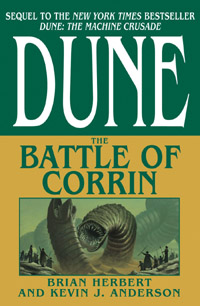
Dune: The Battle of Corrin is a 2004 science fiction novel by Brian Herbert and Kevin J. Anderson, set in the fictional Dune universe created by Frank Herbert. It is the third book in the Legends of Dune prequel trilogy, which takes place over 10,000 years before the events of Frank Herbert's celebrated 1965 novel Dune. The series chronicles the fictional Butlerian Jihad, a crusade by the last free humans in the universe against the thinking machines, a violent and dominating force led by the sentient computer Omnius.
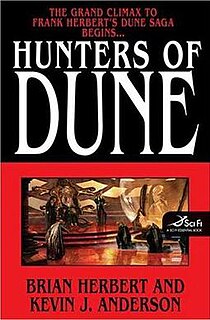
Hunters of Dune is the first of two books written by Brian Herbert and Kevin J. Anderson to conclude Frank Herbert's original Dune series of science fiction novels.
This is a list of terminology used in the fictional Dune universe created by Frank Herbert, the primary source being "Terminology of the Imperium", the glossary contained in the novel Dune (1965).
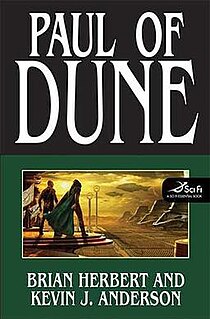
Paul of Dune is a 2008 science fiction novel written by Brian Herbert and Kevin J. Anderson, set in the Dune universe created by Frank Herbert. Released on September 16, 2008, it is the first book in the Heroes of Dune series and chronicles events between Frank Herbert's Dune (1965) and Dune Messiah (1969), as well as between Dune and its 2001 Brian Herbert/Kevin J. Anderson prequel, Dune: House Corrino.
In psychology, genetic memory is a memory present at birth that exists in the absence of sensory experience, and is incorporated into the genome over long spans of time. It is based on the idea that common experiences of a species become incorporated into its genetic code, not by a Lamarckian process that encodes specific memories but by a much vaguer tendency to encode a readiness to respond in certain ways to certain stimuli.
"Committee of the Whole" is a short story by American science fiction author Frank Herbert; it first appeared in Galaxy magazine in April 1965, and later in Herbert's 1985 short story collection The Worlds of Frank Herbert. It deals with the concept of restraint as a paramount virtue necessary for survival of a human race in times when both information and the means for production of weapons of mass destruction are available to every individual.

Sisterhood of Dune is a 2012 science fiction novel by Brian Herbert and Kevin J. Anderson, set in the Dune universe created by Frank Herbert. It is the first book in their Great Schools of Dune prequel trilogy, which itself is a sequel to their Legends of Dune trilogy. The book is set eighty years after the events of 2004's Dune: The Battle of Corrin, in which the human military finally defeat the thinking machine armies of Omnius. Now, the fledgling Bene Gesserit, Mentat and Suk Schools, as well as the Spacing Guild, are threatened by the independent anti-technology forces gaining power in the aftermath of the Butlerian Jihad. The Great Schools of Dune trilogy, first mentioned by Anderson in a 2010 blog post, will chronicle the early years of these organizations, which figure prominently in the original Dune novels.
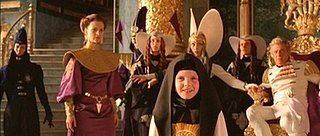
Multiple organizations of the Dune universe dominate the political, religious, and social arena of the fictional setting of Frank Herbert's Dune series of science fiction novels, and derivative works. Set tens of thousands of years in the future, the saga chronicles a civilization which has banned computers but has also developed advanced technology and mental and physical abilities through physical training, eugenics and the use of the drug melange. Specialized groups of individuals have aligned themselves in organizations focusing on specific abilities, technology and goals. Herbert's concepts of human evolution and technology have been analyzed and deconstructed in at least one book, The Science of Dune (2008). His originating 1965 novel Dune is popularly considered one of the greatest science fiction novels of all time, and is frequently cited as the best-selling science fiction novel in history. Dune and its five sequels by Herbert explore the complex and multilayered interactions of politics, religion, ecology and technology, among other themes.
We've a three-point civilization: the Imperial Household balanced against the Federated Great Houses of the Landsraad, and between them, the Guild with its damnable monopoly on interstellar transport.
References
- ↑ Herbert, Frank. The Worlds of Frank Herbert, London: New English Library, 1970. p.117.
- ↑ O'Reilly, Timothy. Frank Herbert. New York: Frederick Ungar, 1980.
- 1 2 Herbert, Frank. The Worlds of Frank Herbert, London: New English Library, 1970. p.120.